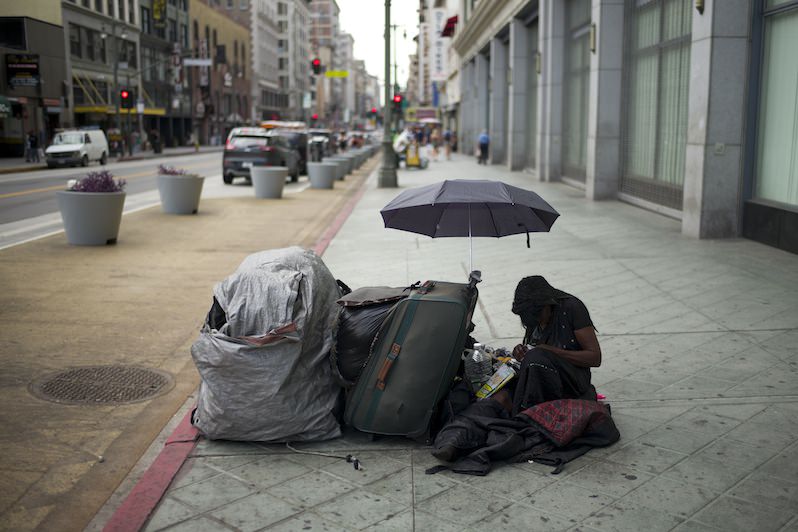Helping the Homeless in the Face of GOP’s Brutal Funding Cuts
The task is labor-intensive, beginning with interviewing one person at a time, and it requires perseverance, patience and a willingness to work against all odds. It is made no easier by a callous, Republican-controlled Congress. A homeless woman sits under an umbrella in downtown Los Angeles. (Jae C. Hong / AP)
A homeless woman sits under an umbrella in downtown Los Angeles. (Jae C. Hong / AP)
This is the final installment in a three-part series on homelessness by Truthdig columnist Bill Boyarsky.
READ:
Part 1: Why Ending Homelessness Is Political Poison
Part 2: Go Directly to Jail: Punishing the Homeless for Being Homeless
Logan Siler was driving near Interstate 210 when he spotted the man, who was slender, perhaps in his late 40s and wearing shorts and a blue sweatshirt. His hair was cut short. He was standing alone.
Siler, 31, an outreach worker for Union Station Homeless Services, pulled his van over to the curb. Something about the man indicated homelessness. Siler picked up a bag lunch and a clipboard with a long questionnaire, and he and I walked over toward the man. Siler then motioned to me to step far to the side. He thought the presence of a reporter might scare the man off. Also, Siler didn’t want me to compromise the confidentiality of the conversation he hoped to have.
The man accepted the bag lunch, and — won over by Siler’s friendly, unassuming manner — crossed the street with him. Siler knew what he was doing; previously, he had worked with the youths of San Francisco’s Haight-Ashbury district.
I watched from several feet away, partly concealed by a fence. They sat down on the sidewalk, in the shade of the freeway overpass. Siler talked to the man and filled out the 19-page questionnaire. The man was talkative. The two of them got along well. After a half-hour, they got up, and Siler shook his hand and said goodbye. We went back to the van and drove away. Siler didn’t know how things would work out. The man had seemed a bit unsettled mentally. Later, Rabbi Marvin Gross, Union Station’s CEO, told me that the goal is to put him and others like him into permanent housing.
The task is labor-intensive, beginning with interviewing one person at a time, and it requires perseverance, patience and a willingness to work against all odds.
Outreach workers from other agencies throughout Los Angeles County use the same questionnaire that Siler used. The workers ask dozens of questions about illness, addiction, arrests, years on the street, education, family status and other highly personal topics. I asked Siler why people would answer such questions. “They’re actually a conversation opener,” he said, adding that people on the street often appreciate the attention.
When Siler returned to his office, he entered the information into a countywide database. On a 1-to-10 scale, the homeless are rated on the seriousness of their conditions. Those most at risk for death or serious illness have a better chance of getting housing. As is the case with almost everything these days, data rules.
There are also several kinds of housing. John Maceri of Lamp Community, a longtime Skid Row housing and treatment provider, said his organization maintains laundry and shower facilities and 161 dormitory-style beds on Skid Row as temporary housing. In addition, it has a 38-bed recuperative center and permanent housing, including apartments, elsewhere.
The most popular program of its kind in the Los Angeles area is called Housing First, popularized by Zev Yaroslavsky and others when Yaroslavsky was a Los Angeles County supervisor. It’s based on a theory that if you put homeless people, even ones who are disturbed, in apartments of their own, they will take command of their lives with the help of counselors and medical people from the social service agency sponsoring them. Proponents of the system say the success rate is high.
How do homeless assistance groups find people who need help?
“On the street,” Maceri said, and “in public spaces.” People will also come into the Lamp office asking to have a shower or use the bathroom, he added.
But for every homeless person saved, the Republican-controlled Congress consigns many more to the streets by reducing federal aid for low-rent housing and other services.
Housing for the homeless, either in apartments or group homes, is financed by a bewildering number of federal programs, most of which are losing funding. One crucial federal program, HOME, had been cut by Congress from $1.2 billion to $900 million and then again to $66 million. The homeless languish on waiting lists for months, sometimes years, before getting an apartment paid for by a federal voucher.
“In recent years, Congress has made deep cuts to many programs,” the Center on Budget Priorities and Policy, a progressive Washington research organization, says on its website. “The federal government spends 2.8 times as much on tax subsidies for homeownership — more than half of which benefits households with incomes above $100,000 — as on rental assistance.”In addition, it’s tough to find landlords who will accept federal vouchers or who will agree to take in homeless, troubled tenants in high-rent cities like Los Angeles. With Washington’s abdication of responsibility, the job is left to creative local social service agencies and government officials.
Mollie Lowery, a consultant and former director at Housing Works, said she and her colleagues must persuade landlords that homeless clients would be good tenants. “We have to depend on our relationship with landlords and developers. … We tell them our tenants may be more complicated but we will be with them 24/7” offering psychological and medical help.
I talked to Steve Clare, the executive director of the Venice Community Housing Corp., at his office across Rose Avenue from a sizable Whole Foods, a sign of the gentrification that is driving up housing prices in the beach community. He told me that nonprofit organizations like his often have to be entrepreneurial.
For example, when Clare found a property in Venice big enough for an apartment house, he had to obtain a $1 million grant from the nonprofit Corporation for Supportive Housing, which is supported by the Conrad N. Hilton Foundation. A housing corporation board member lent an additional $850,000, and he then persuaded Los Angeles County and city officials to chip in $2 million. Finally, tax credits from the state made it profitable for a private developer to build the apartment house and charge rent within housing voucher limits.
To help ease the situation, Los Angeles Mayor Eric Garcetti is preparing a proposal that will utilize outreach workers like Siler and build apartments as Clare and others have done. In addition, he wants more tax subsidies to persuade developers to build apartment houses.
“We first have to start with outreach workers,” Garcetti told me. “We have eight teams, 16 people for the entire county of Los Angeles. In the budget, I doubled this. The city has never done this before. I’ll put another 10 teams or 20 people out. If we are going to be serious about housing about 10,000 people a year, we probably need 500 outreach workers over the next two or three years.”
He then said he would hire additional case managers, “literally in the hundreds,” to arrange for housing and care, because “you need … the actual people who find the housing and do the referrals … for homeless folks, even if you have an outreach worker.”
“Here’s the problem with that,” I replied. “The number of housing vouchers has been sharply reduced by the Republican House of Representatives.”
Garcetti said, “And if you have a voucher, you can’t necessarily find housing.” He said a homeless man who visited him two days earlier complained that he couldn’t find an apartment that would accept his voucher.
The mayor told me he was working with California state Assembly Speaker Toni Atkins to pass legislation that would expand the program of giving tax credits to developers who build low-rent apartments. Those credits would stimulate $3 billion to $4 billion in construction, he estimated.
That would help. Unfortunately, the complex problem of homelessness has not received a mention on the presidential campaign. The congressional aid cuts are all but unnoticed, and while the country has looked away, homelessness has become a great national tragedy.
Your support matters…Independent journalism is under threat and overshadowed by heavily funded mainstream media.
You can help level the playing field. Become a member.
Your tax-deductible contribution keeps us digging beneath the headlines to give you thought-provoking, investigative reporting and analysis that unearths what's really happening- without compromise.
Give today to support our courageous, independent journalists.






You need to be a supporter to comment.
There are currently no responses to this article.
Be the first to respond.